SKODA SUPERB 2007 1.G / (B5/3U) Owner's Manual
Manufacturer: SKODA, Model Year: 2007, Model line: SUPERB, Model: SKODA SUPERB 2007 1.G / (B5/3U)Pages: 259, PDF Size: 14.71 MB
Page 191 of 259
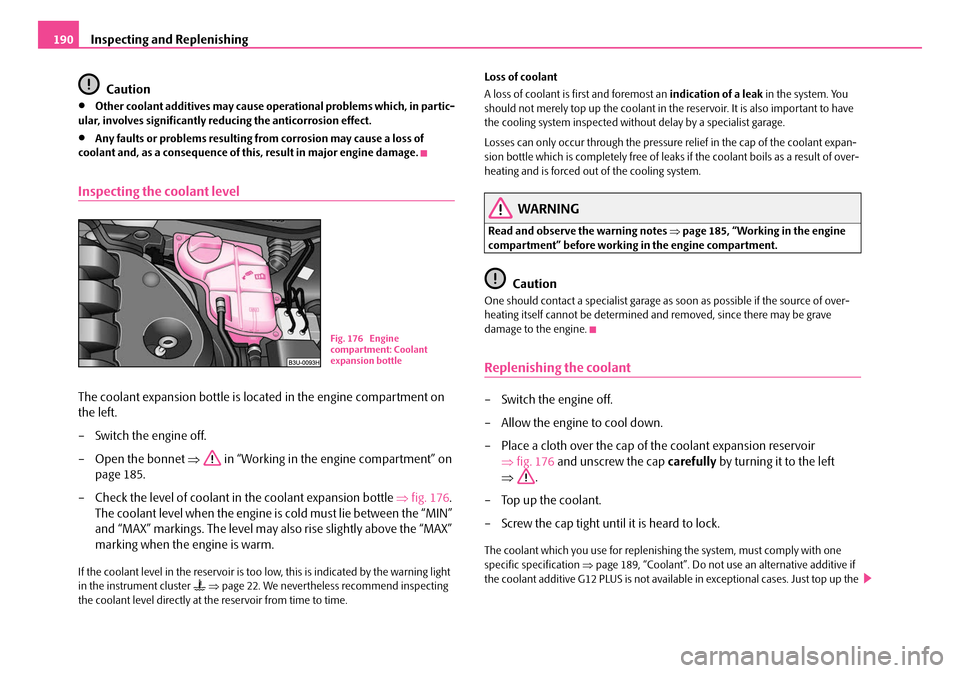
Inspecting and Replenishing
190
Caution
•Other coolant additives may cause operational problems which, in partic-
ular, involves significantly reducing the anticorrosion effect.
•Any faults or problems resulting from corrosion may cause a loss of
coolant and, as a consequence of th is, result in major engine damage.
Inspecting the coolant level
The coolant expansion bottle is located in the engine compartment on
the left.
– Switch the engine off.
– Open the bonnet ⇒ in “Working in the engine compartment” on
page 185.
– Check the level of coolant in the coolant expansion bottle ⇒fig. 176 .
The coolant level when the engine is cold must lie between the “MIN”
and “MAX” markings. The level may also rise slightly above the “MAX”
marking when the engine is warm.
If the coolant level in the reservoir is too low, this is indicated by the warning light
in the instrument cluster ⇒ page 22. We nevertheless recommend inspecting
the coolant level directly at th e reservoir from time to time. Loss of coolant
A loss of coolant is first and foremost an
indication of a leak in the system. You
should not merely top up the coolant in the reservoir. It is also important to have
the cooling system inspected without delay by a specialist garage.
Losses can only occur through the pressure relief in the cap of the coolant expan-
sion bottle which is completely free of leaks if the coolant boils as a result of over-
heating and is forced out of the cooling system.
WARNING
Read and observe the warning notes ⇒page 185, “Working in the engine
compartment” before working in the engine compartment.
Caution
One should contact a specialist garage as soon as possible if the source of over-
heating itself cannot be determined and removed, since there may be grave
damage to the engine.
Replenishing the coolant
– Switch the engine off.
– Allow the engine to cool down.
– Place a cloth over the cap of the coolant expansion reservoir ⇒fig. 176 and unscrew the cap carefully by turning it to the left
⇒ .
– Top up the coolant.
– Screw the cap tight until it is heard to lock.
The coolant which you use for replenishing the system, must comply with one
specific specification ⇒page 189, “Coolant”. Do not use an alternative additive if
the coolant additive G12 PLUS is not available in exceptional cases. Just top up the
B1Z-0042HB1Z-0042H
Fig. 176 Engine
compartment: Coolant
expansion bottle
NKO B5 20.book Page 190 Friday, March 2, 2007 1:46 PM
Page 192 of 259
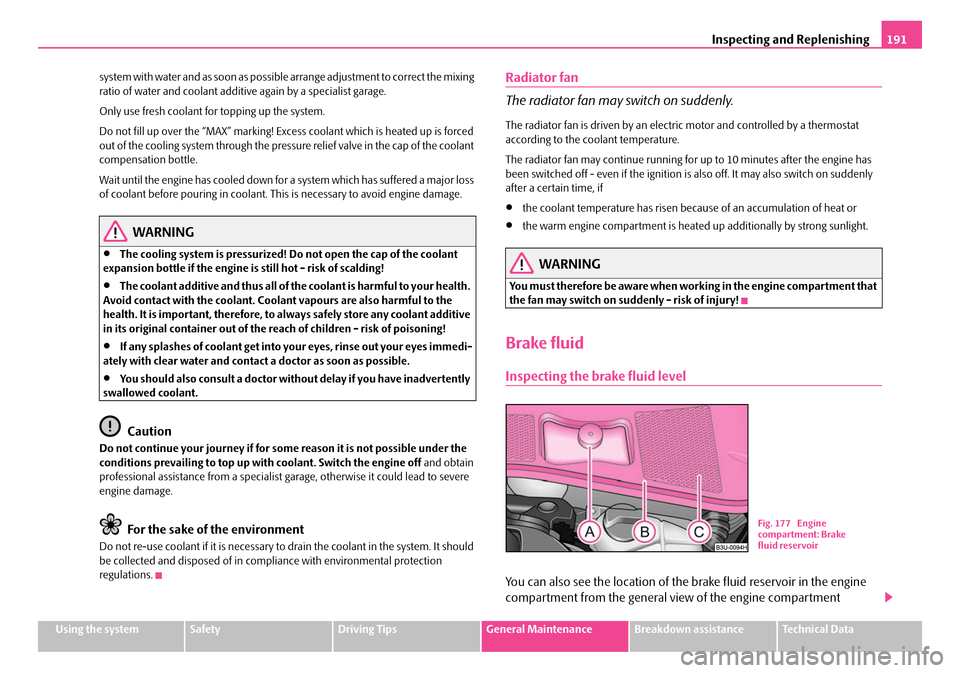
Inspecting and Replenishing191
Using the systemSafetyDriving TipsGeneral MaintenanceBreakdown assistanceTechnical Data
system with water and as soon as possible arrange adjustment to correct the mixing
ratio of water and coolant additive again by a specialist garage.
Only use fresh coolant for topping up the system.
Do not fill up over the “MAX” marking! Exce
ss coolant which is heated up is forced
out of the cooling system through the pressu re relief valve in the cap of the coolant
compensation bottle.
Wait until the engine has cooled down for a system which has suffered a major loss
of coolant before pouring in coolant. Th is is necessary to avoid engine damage.
WARNING
•The cooling system is pressurized! Do not open the cap of the coolant
expansion bottle if the engine is still hot - risk of scalding!
•The coolant additive and thus all of the coolant is harmful to your health.
Avoid contact with the coolant. Coolant vapours are also harmful to the
health. It is important, therefore, to always safely store any coolant additive
in its original container out of the reach of children - risk of poisoning!
•If any splashes of coolant get into yo ur eyes, rinse out your eyes immedi-
ately with clear water and contact a doctor as soon as possible.
•You should also consult a doctor without delay if you have inadvertently
swallowed coolant.
Caution
Do not continue your journey if for some reason it is not possible under the
conditions prevailing to top up with coolant. Switch the engine off and obtain
professional assistance from a specialist garage, otherwise it could lead to severe
engine damage.
For the sake of the environment
Do not re-use coolant if it is necessary to drain the coolant in the system. It should
be collected and disposed of in comp liance with environmental protection
regulations.
Radiator fan
The radiator fan may switch on suddenly.
The radiator fan is driven by an electr ic motor and controlled by a thermostat
according to the coolant temperature.
The radiator fan may conti nue running for up to 10 mi nutes after the engine has
been switched off - even if the ignition is also off. It may also switch on suddenly
after a certain time, if
•the coolant temperature has risen because of an accumulation of heat or
•the warm engine compartmen t is heated up additionally by strong sunlight.
WARNING
You must therefore be aware when working in the engine compartment that
the fan may switch on suddenly - risk of injury!
Brake fluid
Inspecting the brake fluid level
You can also see the location of the brake fluid reservoir in the engine
compartment from the general view of the engine compartment
B1Z-0042HB1Z-0042H
Fig. 177 Engine
compartment: Brake
fluid reservoir
NKO B5 20.book Page 191 Friday, March 2, 2007 1:46 PM
Page 193 of 259

Inspecting and Replenishing
192
⇒page 186. The brake fluid reservoir on right-hand steering models is
positioned on the other side of the engine compartment.
– Switch the engine off.
– Open the bonnet ⇒ in “Working in the engine compartment” on
page 185.
– Pull off the rubber seal ⇒page 191, fig. 177 partially away and lift
the cover slightly.
– Inspect the brake fluid level at the reservoir . The level must be
between the “MIN” and “MAX” markings. The markings are indicated
on the side of the reservoir.
A slight drop in the fluid level results when driving due to normal wear-and-tear
and automatic adjustment of the br ake pads, and is perfectly normal.
There may be an indication of a leak in th e brake system, however, if the fluid level
drops significantly within a short time or if it drops below the “MIN” marking. A situ-
ation where the brake fluid level is too low is indicated by the warning light
lighting up in the instrument cluster ⇒page 29. In this case stop the car immedi-
ately and do not drive any further! Cont act a Škoda Dealer to obtain profes-
sional assistance.
WARNING
•Read and observe the warning notes ⇒page 185, “Working in the engine
compartment” before working in the engine compartment.
•If the fluid level has dropped below the MIN marking, do not drive any
further - risk of accident! Contact a Škoda dealer to obtain professional
assistance.
Replacing brake fluid
Brake fluid absorbs moisture. This causes the fluid to absorb moisture from the
surrounding air over a period of time. Excessive water in the brake fluid may be the
cause of corrosion in the brake system. Th e water content also lowers the boiling point of the brake fluid.
This is why brake fluid mu st be replaced every two
years.
One may only use new genuine brake fluid from Škoda Auto a.s. The specification
for the brake fluid is “FMVSS 116 DOT 4”.
We recommend that you have the brake fluid replaced by a Škoda Service Partner
as part of an Inspection Service.
WARNING
•Using old brake fluid can result in seve re stress on the brakes because of
the formation of vapour bubbles in th e brake system. This greatly impairs
the braking efficiency and thus al so the safety of your vehicle.
•Brake fluid is toxic! It must therefore be kept safely in closed original
containers and well away from children and unauthorized persons.
Caution
Brake fluid damages the paintwork of the vehicle.
For the sake of the environment
In view of the problems involved with prop er disposal of brake fluid, the special
tools and the professional knowledge required, you should have the brake fluid
replaced by a Škoda Service Partner.
AB
AC
AA
NKO B5 20.book Page 192 Friday, March 2, 2007 1:46 PM
Page 194 of 259

Inspecting and Replenishing193
Using the systemSafetyDriving TipsGeneral MaintenanceBreakdown assistanceTechnical Data
Battery
Working on the battery
Particular care is required when carrying out any work on the
battery!
The battery is located in the engine compartment in the plenum chamber
below a cover.
Taking off cover
– Press the cover in direction of arrow ⇒fig. 178 .
There is a risk of injuries, scalding, acci dents and burns when carrying out any work
on the battery and on the electrical system. For this reason, it is essential to comply
with the warning instructions ⇒ stated below and with the general applicable
rules of safety.
WARNING
•The battery acid is strongly corros ive and must, therefore, be handled
with the greatest of care. Always we ar protective gloves, eye and skin
protection when handling batteries. Corrosive fumes in the air irritate the
air passages and lead to conjunctivitis and inflammation of the air passages in the lungs. Battery acid corrodes de
ntal enamel and creates deep wounds
after contact with the skin which take a long time to heal. Repeated contact
with diluted acids causes skin diseases (inflammations, ulcers, slin cracks).
Acids coming into contact with water are diluted accompanied by significant
development of heat.
•Do not tilt the battery otherwise battery electrolyte may flow out of the
battery vent openings. Protect the eyes with safety glasses or a shield! There
is the danger of suffering blindness! If any battery electrolyte gets into your
eye, rinse out your eye immediately with clear water for several minutes.
Contact a doctor without delay.
•Splashes of acid on your skin or clothes should be neutralised as soon as
possible using soap suds and then rinsed with plenty of water. Contact a
doctor immediately if you swallow battery electrolyte.
•Keep batteries out of the reach of children.
•Hydrogen is released when you char ge a battery and a highly explosive
gas mixture is produced. An explosion can be caused through sparkling over
during unclamping or loosening of the cable plug while the ignition is on.
•Bridging of the poles will create a short circuit (e.g. through metal
objects, cables). Possible consequences of a short circuit: Melting of lead
struts, explosion and burning of the battery, jets of acid spurting out.
•It is prohibited to work with a naked flame and light, to smoke or to carry
out any activities which produce sparks. Avoid creating sparks when
working with cables and electrical device s. Strong sparking represents a risk
of injury.
•Before carrying out any work on the electrical system, switch off the
engine, the ignition as well as all electrical components and disconnect the
negative cable (-) on the battery. If you wish to replace a bulb it is sufficient
to switch off the appropriate light.
•Never charge a frozen or thawed battery - risk of explosion and caustic
burns! Replace a frozen battery.
•Never use a battery which is damaged - risk of explosion! Immediately
replace a damaged battery.
B1Z-0042HB1Z-0042H
Fig. 178 Engine
compartment: plenum
chamber - battery cover
WARNING (continued)
NKO B5 20.book Page 193 Friday, March 2, 2007 1:46 PM
Page 195 of 259

Inspecting and Replenishing
194
Caution
•You must only disconnect the battery if the ignition is switched off, otherwise
the electrical system (electronic components) of the vehicle may be damaged.
When disconnecting the battery from the electrical system of the vehicle, first
disconnect the negati ve terminal (-) of the battery. Then disconnect the positive
terminal (+).
•When reconnecting the battery, first connec t the positive terminal (+) and only
then the negative terminal (-) of the battery. You must on no account connect the
cables wrongly - risk of a cable fire!
•Ensure that battery acid does not come into contact with the vehicle body
otherwise damage could occur to the paintwork.
•Do not place the battery in direct dayl ight in order to protect the battery
housing from the effects of ultra-violet light.
For the sake of the environment
A removed battery is a special type of waste which is harmful to the environment -
contact your specialist garage regarding disposing of the battery.
Note
Please also refer to the guidelines ⇒page 196, “Disconnecting and reconnecting
the battery”, also after connecting the battery.
Battery with a charge level indicator, the so-called magic eye
There is a so-called magic eye ⇒fig. 179 located on the top of the battery. The
“magic eye” changes its colour in line with the charge state of and electrolyte level
in the battery.
Air bubbles can influence the colour of the “magic eye”. For this reason carefully
knock on the “magic eye” before carrying out the check.
•Green colour - the battery is adequately charged
•Dark colour - the battery has to be charged
•Colourless or yellow colour. Have the battery checked by a specialist garage
Batteries, which are more than 5 years old, must be replaced. We recommend you
have the electrolyte level inspected and adjusted to the correct level or the battery
replaced if necessary by a specialist garage.
Caution
If the vehicle has not been driven for more than 3 to 4 weeks, the battery will
discharge because certain electrical comp onents consume electricity (e.g. control
units) also in idle state. You can prevent the discharging of the battery by discon-
necting the negative terminal or charging the battery constantly with a very low
charging current. Please also refer to the notes when working on the battery
⇒ page 193, “Working on the battery”.
Fig. 179 Engine
compartment: Battery
with magic eye
NKO B5 20.book Page 194 Friday, March 2, 2007 1:46 PM
Page 196 of 259

Inspecting and Replenishing195
Using the systemSafetyDriving TipsGeneral MaintenanceBreakdown assistanceTechnical Data
Inspecting the electrolyte level
The battery is practically maintenance-free under normal oper ating conditions.
We do, however, recommend that you have the electrolyte level inspected from
time to time by a specialist garage when outside temperatures are high or when
driving on long trips. You should also check the electrolyte level ⇒page 195 each
time the battery is charged.
The battery acid level will also be chec ked as part of the Inspection Service.
Operation in winter
The battery has to provide greater amounts of electricity during the winter. It also
has only part of the initial power output at low temperatures that it has at normal
temperatures.
A discharged battery may already freez e at temperatures just below 0°C.
We therefore recommend that you have the battery checked by a specialist garage
before the start of the winter, and recharged if necessary.
Note
If the vehicle is not going to be driven for a period of some weeks when there is very
severe frost one should remove ⇒page 196 the battery and store it in a place
which is protected from frost. This prevents the battery from freezing up and
thereby being destroyed.
Charging the battery
A properly charged battery is essential for reliably starting the
engine.
–Read the warning notes ⇒ in “Working on the battery” on
page 193 and ⇒.
– Switch the ignition and all electrical components off. – Only for “quick-charging”: Disconnect
both battery cables (first of all
“negative”, then “positive”).
– Carefully attach the terminal clamps of the charger to the battery terminals (red = “positive”, black = “negative”).
– You can now plug the mains cable of the charger into the power socket
and switch on the charger.
– When charging is completed: switch the charger off and unplug the mains cable from the power socket.
– Only then should you disconnect the terminal clamps of the charger.
– Reconnect the cables to the battery (first of all “positive”, then “nega- tive”).
It is not normally necessary to disconnect the cables of the battery if you recharge
the battery using low amperages (as for example from a mini-charger). Please also
refer to the instructions from the charger manufacturer.
A charging current of 0.1 of the total battery capacity (or lower) is that which should
be used until full charging is achieved.
It is, however, necess ary to disconnect both cables be fore charging the battery with
high amperages, so-called “ quick-charging”.
“Quick-charging” a battery is dangerous ⇒ in “Working on the battery” on
page 193. It requires a special charger an d appropriate knowledge. We therefore
recommend that you have your battery qu ick-charged only by your specialist
garage.
A discharged battery may already freeze at temperatures just below 0°C. ⇒. We
recommend that you no longer use a ba ttery which has thawed out because the
casing of the battery may be cracked through the formation of ice and this would
allow battery electrolyte to flow out.
The vent plugs of the battery should not be opened for charging.
NKO B5 20.book Page 195 Friday, March 2, 2007 1:46 PM
Page 197 of 259

Inspecting and Replenishing
196
WARNING
Never charge a frozen or thawed battery - risk of explosion and caustic
burns. Replace a frozen battery.
Removing and installing the battery
Removing and installing the battery
– Please also refer to the note s when working on the battery
⇒ page 193.
– Switched off all electrical components and remove the ignition key. – Pull off gasket and take out the cover of the plenum chamber
in the direction of the arrow ⇒fig. 180 .
– Unclamp the battery negative terminal (-).
– Unclamp the battery positive terminal (+).
– Unscrew the screw ⇒ fig. 181 completely and remove the locking
plate.
– Move the battery in the direction of the arrow and pull it out in an upward direction.
– Installation takes plac e in the reverse order.
Please also refer to the following no tes when connecting up the battery
⇒ page 196.
Note
We do not recommend that you remove and install the battery yourself (even when
you are following the instructions given in this Owner's manual) since a battery can
be heavily damaged in the process und er certain circumstances. Contact a
specialist garage.
Disconnecting and reconnecting the battery
On disconnecting and reconnecting the batt ery the following functions are initially
deactivated or are no longer able to operate fault-free.
Fig. 180 Engine
compartment: plenum
chamber - cover
Fig. 181 Engine
compartment: The
battery
AAAB
AC
NKO B5 20.book Page 196 Friday, March 2, 2007 1:46 PM
Page 198 of 259
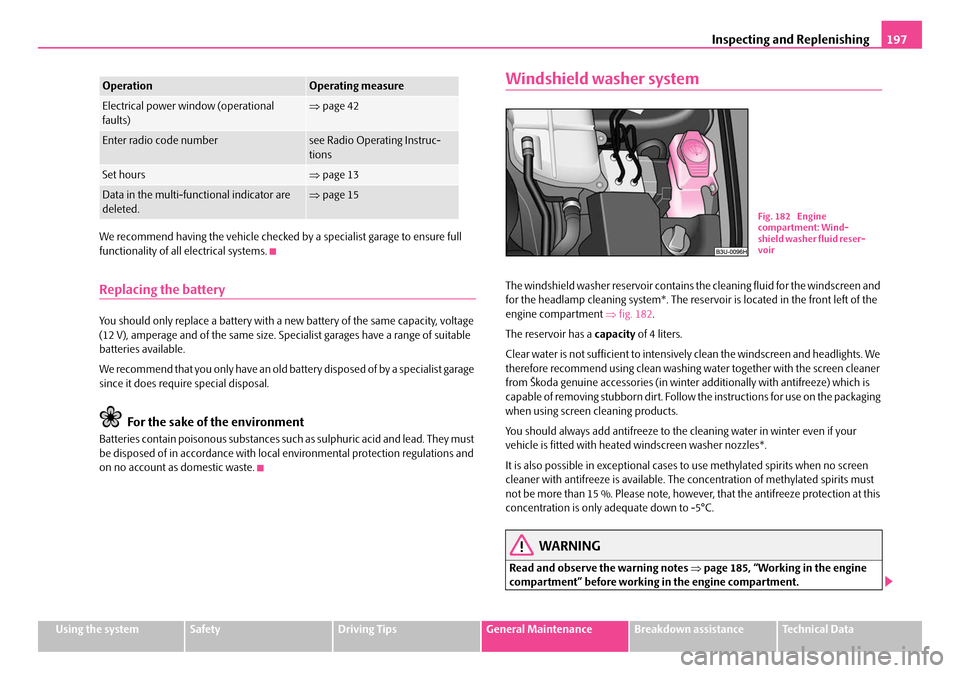
Inspecting and Replenishing197
Using the systemSafetyDriving TipsGeneral MaintenanceBreakdown assistanceTechnical Data
We recommend having the ve
hicle checked by a specialist garage to ensure full
functionality of all electrical systems.
Replacing the battery
You should only replace a battery with a new battery of the same capacity, voltage
(12 V), amperage and of the same size. Specialist garages have a range of suitable
batteries available.
We recommend that you only have an old battery disposed of by a specialist garage
since it does require special disposal.
For the sake of the environment
Batteries contain poisonous substances such as sulphuric acid and lead. They must
be disposed of in accordance with loca l environmental protection regulations and
on no account as domestic waste.
Windshield washer system
The windshield washer reservoir contains the cleaning fluid for the windscreen and
for the headlamp cleaning system*. The rese rvoir is located in the front left of the
engine compartment ⇒fig. 182 .
The reservoir has a capacity of 4 liters.
Clear water is not sufficient to intensivel y clean the windscreen and headlights. We
therefore recommend using clean washing water together with the screen cleaner
from Škoda genuine accessories (in winter additionally with antifreeze) which is
capable of removing stubborn dirt. Follow the instructions for use on the packaging
when using screen cleaning products.
You should always add antifreeze to the cleaning water in winter even if your
vehicle is fitted with heated windscreen washer nozzles*.
It is also possible in exceptional cases to use methylated spirits when no screen
cleaner with antifreeze is available. The concentration of methylated spirits must
not be more than 15 %. Please note, however, that the antifreeze protection at this
concentration is only adequate down to -5°C.
WARNING
Read and observe the warning notes ⇒page 185, “Working in the engine
compartment” before working in the engine compartment.
OperationOperating measure
Electrical power window (operational
faults)⇒ page 42
Enter radio code numbersee Radio Operating Instruc-
tions
Set hours⇒page 13
Data in the multi-functional indicator are
deleted.⇒page 15
B1Z-0042HB1Z-0042H
Fig. 182 Engine
compartment: Wind-
shield washer fluid reser-
voir
NKO B5 20.book Page 197 Friday, March 2, 2007 1:46 PM
Page 199 of 259
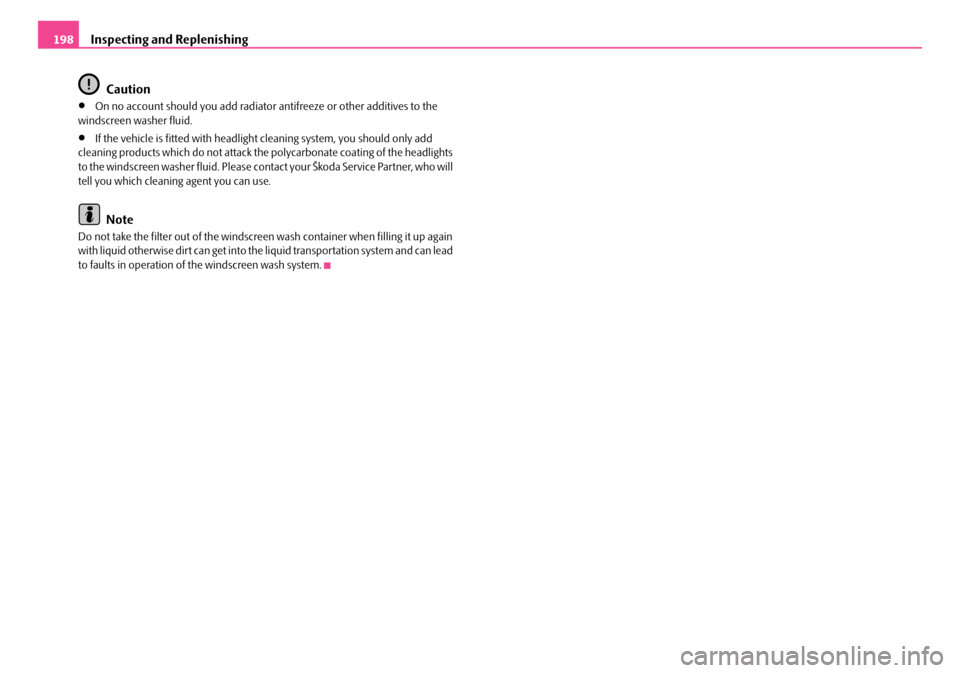
Inspecting and Replenishing
198
Caution
•On no account should you add radiator antifreeze or other additives to the
windscreen washer fluid.
•If the vehicle is fitted with headligh t cleaning system, you should only add
cleaning products which do not attack th e polycarbonate coating of the headlights
to the windscreen washer fluid. Please contact your Škoda Service Partner, who will
tell you which cleaning agent you can use.
Note
Do not take the filter out of the windscreen wash container when filling it up again
with liquid otherwise dirt can get into the liquid transportation system and can lead
to faults in operation of the windscreen wash system.
NKO B5 20.book Page 198 Friday, March 2, 2007 1:46 PM
Page 200 of 259
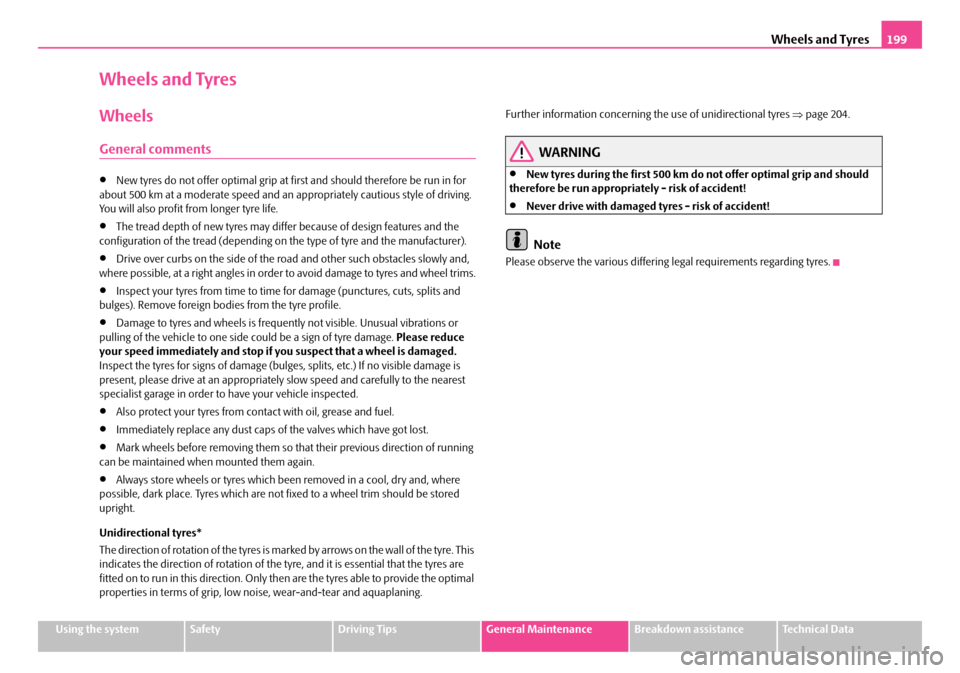
Wheels and Tyres199
Using the systemSafetyDriving TipsGeneral MaintenanceBreakdown assistanceTechnical Data
Wheels and Tyres
Wheels
General comments
•New tyres do not offer optimal grip at first and should therefore be run in for
about 500 km at a moderate speed and an appropriately cautious style of driving.
You will also profit from longer tyre life.
•The tread depth of new tyres may differ because of design features and the
configuration of the tread (depending on the type of tyre and the manufacturer).
•Drive over curbs on the side of the road and other such obstacles slowly and,
where possible, at a right angles in order to avoid damage to tyres and wheel trims.
•Inspect your tyres from time to time for damage (punctures, cuts, splits and
bulges). Remove foreign bodies from the tyre profile.
•Damage to tyres and wheels is frequent ly not visible. Unusual vibrations or
pulling of the vehicle to one side could be a sign of tyre damage. Please reduce
your speed immediately and stop if you suspect that a wheel is damaged.
Inspect the tyres for signs of damage (bulge s, splits, etc.) If no visible damage is
present, please drive at an appropriatel y slow speed and carefully to the nearest
specialist garage in order to have your vehicle inspected.
•Also protect your tyres from contact with oil, grease and fuel.
•Immediately replace any dust caps of the valves which have got lost.
•Mark wheels before removing them so th at their previous direction of running
can be maintained when mounted them again.
•Always store wheels or tyres which been removed in a cool, dry and, where
possible, dark place. Tyres which are not fixed to a wheel trim should be stored
upright.
Unidirectional tyres*
The direction of rotation of the tyres is marked by arrows on the wall of the tyre. This
indicates the direction of rotation of the tyre, and it is essential that the tyres are
fitted on to run in this direction. Only then are the tyres able to provide the optimal
properties in terms of grip, low noise, wear-and-tear and aquaplaning. Further information concerning
the use of unidirectional tyres ⇒page 204.
WARNING
•New tyres during the first 500 km do not offer optimal grip and should
therefore be run appropriately - risk of accident!
•Never drive with damaged tyres - risk of accident!
Note
Please observe the various differing legal requirements regarding tyres.
NKO B5 20.book Page 199 Friday, March 2, 2007 1:46 PM